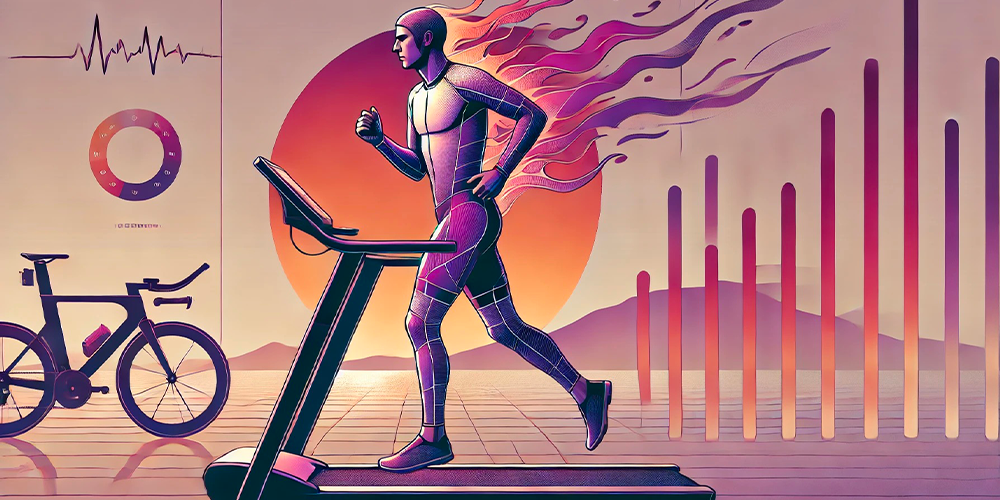Which triathlete has never seen Kristian Blummenfelt or the Brownlee brothers training under a tent or in a lab to simulate heat? Everyone knows that training in the heat is beneficial for performance. Everyone is familiar with or has some understanding of physical exercise and the principles of homeostasis. However, few of us make the effort to combine physical exercise with heat, except in summer. Yet, the benefits are such that the best athletes train all year round with heat and maintain their heat threshold year-round through weekly sessions.
Article published in TrimaX-magazine n°237 – May 2024 / Author: Simon Billeau
This article was provided to us by Trimax Magazine, one of the leading triathlon magazines. A new edition is published every month, featuring articles, profiles, race tips, equipment advice, and much more. To discover all the latest news in triathlon, cycling, running, duathlon, and swimrun for free, click here.
For various reasons that we will explain later, the Core Body Temperature suit for heat training is an essential tool in the range of training tools for triathletes. But first, let’s quickly explain what science tells us about human biology and the effects of heat during physical exertion.
Heat Training
By its very nature, exercise constitutes a challenge for the body’s cellular homeostatic mechanisms. This homeostatic challenge affects not only the contraction of skeletal muscles but also a number of other organs and leads, over time, to exercise-induced adaptations.
Heat training is recognized as having numerous benefits on human biology. Science has highlighted positive effects for endurance sports in terms of increasing muscle mass, strength, and also brain function.
Exposure to a stress factor like heat triggers a cellular response that includes the induction of HSP (heat shock proteins) and leads to a type of adaptation of individual cells, organs, or even the entire organism. This adaptation means that future stress factors will not have the same impact as during the initial exposure.
Consequently, heat training can be used to “train” the body to handle future stress factors. This is known as the principle of specificity. Exercise is one of these prior stresses, and exposure to heat is another.
Effects of Heat Training
Combining training with a hot environment could potentially be advantageous for performance, providing a protective thermotolerance effect to any subsequent thermal stress during exercise. Indeed, the combination of exercise and heat exposure can lead to a higher expression of HSP than either treatment alone, according to Skidmore R. et al., 1995.
Furthermore, the article by Tamura and colleagues in 2014 suggests that whole-body heat stress after training additively enhances endurance training-induced mitochondrial adaptations in skeletal muscles. The authors suggest that heat stress could act as an effective constraint to improve mitochondrial adaptations in skeletal muscle.
It is therefore not surprising that heat shock proteins (HSP), a group of cytoprotective proteins essential for maintaining protein and cellular homeostasis, have been implicated in exercise-induced adaptations. These proteins and other chemical responses result from heat exposure, such as a sauna session, intense training, a hot bath, to name a few examples.
Sauna sessions are known to notably increase blood volume. This results in a lower resting heart rate, and these sessions have effects similar to the doping substance EPO. Runners subjected to a training regimen where 2 sessions were followed by heat exposure in a sauna showed a 32% improvement in time to exhaustion, correlating with blood markers.
Heat exposure also affects muscle glycogen usage. As you know, muscle glycogen is simply sugar that our muscles store to produce energy. But these reserves are limited, hence the interest in conserving them. In a study on 8-day heat training, athletes used between 40 and 50% less muscle glycogen than before the acclimation period.
Heat training offers significant benefits to increase muscle strength, notably through hypertrophy. Heat induces a change in the protein synthesis process in that muscles degrade less easily after physical efforts, and muscle production is accelerated. Heat exposure is therefore a useful tool whether you are healthy or injured.
Finally, there are the effects of heat on the endocrine system. Heat exposure slightly increases norepinephrine, prolactin, endorphins, and growth hormones. Everyone knows what growth hormones do. But the other hormones also bring their benefits. Prolactin promotes the production of myelin, the sheath that surrounds axons, responsible for transmitting nerve impulses from our brain to muscles. This has implications for improving the ability to learn new skills, as well as reaction times.
That’s the science. As you have understood, heat training is the new method used by Norwegians and high-performing athletes.
Testing the Suit
To undergo heat training, the environment in which we live is sometimes not conducive to heat exposure, such as in metropolitan France in winter. Also, not everyone has a sauna at home. This is why this suit from Body Core Temp is interesting. It is a sort of portable sauna. Made of polyethylene and polypropylene, it allows you to increase temperature more quickly and with less intense physical effort, according to Body Core Temp.
So, I wanted to check if this product, which can be used either running or cycling indoors, does what it is said to do. As a preamble, to limit the influence of bias, I consumed the same meals on the days preceding the tests, eliminated caffeine consumption 2 hours before, and conducted the tests at the same time of day.
Furthermore, to control factors such as external temperature and humidity, I performed the tests inside my house equipped with air conditioning set at 26°C on days when humidity was between 50 and 60%. I also used the same cycling shorts. I did not consume any drinks during the entire test.
Here are the conditions of the 2 tests and their results for pre and post-test body weight loss (weight), maximum and average temperature (Max Temp and Avg Temp), average heart rate (HR), calories burned (Cal), and training load index (TL for Training Load).
- 1st test: Control – 1h on the home trainer at 150 watts with a fan.
- 2nd test: 1h on the home trainer at 150 watts with the Body Core Temp suit and a fan.
 The temperature results were obtained with the Core Body Temp sensor. As you can see from the table, the weight loss was significantly greater in the second test, indicating much higher sweating, despite the fact that the average and maximum temperature was lower than in the control test.
The temperature results were obtained with the Core Body Temp sensor. As you can see from the table, the weight loss was significantly greater in the second test, indicating much higher sweating, despite the fact that the average and maximum temperature was lower than in the control test.
This indicates that the suit acts as an insulator and that my body tried to protect me from hyperthermia by causing excess sweating, and the pores of the skin release sweat to cool down and lower the temperature.
For comparable effort (1h at 150 watts), the thermal suit allows me to increase the workload, as seen by a 23 beats per minute higher average heart rate.
This suit is therefore ideal for working specifically under thermal stress and optimizing your available training time by making it more challenging. This suit is very effective in improving thermoregulation.
However, precautions must be taken with this type of training. First, I would recommend monitoring your heart rate variability (HRV) with your Whoop bracelet, Oura ring, or any smart watch that calculates it.
Heat training can cause an increase in fatigue and thus a lower HRV. HRV, as everyone knows, is an infallible criterion for knowing your recovery level.
Then, it is absolutely necessary to compensate for fluid losses and minerals contained in sweat. Electrolytes are essential.
Heat training is not easy. I would be lying if I said otherwise! However, it is illusory to imagine reaching peaks by only pedaling downhill… Kristian Blummenfelt does a big heat training block in foundational preparation and maintains this specific capacity with a weekly reminder.
Since my test of this suit over the past 6 months, the Body Core Temp website has removed this product from their list of available products for sale. However, other sites have them in stock. They are available in 2 sizes: Medium for people under 182 cm and XL for those over 182 cm.
The package contains 2 suits for about €27. More information on heat training at: https://corebodytemp.com/


